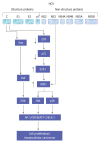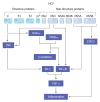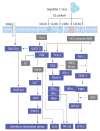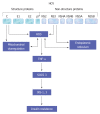Hepatitis C virus-host interactions: Etiopathogenesis and therapeutic strategies
- PMID: 24520529
- PMCID: PMC3905577
- DOI: 10.5493/wjem.v2.i2.7
Hepatitis C virus-host interactions: Etiopathogenesis and therapeutic strategies
Abstract
Hepatitis C virus (HCV) is a significant health problem facing the world. This virus infects more than 170 million people worldwide and is considered the major cause of both acute and chronic hepatitis. Persons become infected mainly through parenteral exposure to infected material by blood transfusions or injections with nonsterile needles. Although the sexual behavior is considered as a high risk factor for HCV infection, the transmission of HCV infection through sexual means, is less frequently. Currently, the available treatment for patients with chronic HCV infection is interferon based therapies alone or in combination with ribavirin and protease inhibitors. Although a sustained virological response of patients to the applied therapy, a great portion of patients did not show any response. HCV infection is mostly associated with progressive liver diseases including fibrosis, cirrhosis and hepatocellular carcinoma. Although the focus of many patients and clinicians is sometimes limited to that problem, the natural history of HCV infection (HCV) is also associated with the development of several extrahepatic manifestations including dermatologic, rheumatologic, neurologic, and nephrologic complications, diabetes, arterial hypertension, autoantibodies and cryglobulins. Despite the notion that HCV-mediated extrahepatic manifestations are credible, the mechanism of their modulation is not fully described in detail. Therefore, the understanding of the molecular mechanisms of HCV-induced alteration of intracellular signal transduction pathways, during the course of HCV infection, may offer novel therapeutic targets for HCV-associated both hepatic and extrahepatic manifestations. This review will elaborate the etiopathogenesis of HCV-host interactions and summarize the current knowledge of HCV-associated diseases and their possible therapeutic strategies.
Keywords: Extrahepatic; Hepatitis C virus; Hepatocellular carcinoma; Signalling; Therapy.
Figures








Similar articles
-
Hepatitis C virus-related hepatocellular carcinoma: An insight into molecular mechanisms and therapeutic strategies.World J Hepatol. 2012 Dec 27;4(12):342-55. doi: 10.4254/wjh.v4.i12.342. World J Hepatol. 2012. PMID: 23355912 Free PMC article.
-
NIH Consensus Statement on Management of Hepatitis C: 2002.NIH Consens State Sci Statements. 2002 Jun 10-12;19(3):1-46. NIH Consens State Sci Statements. 2002. PMID: 14768714 Review.
-
Viral hepatitis.Curr Opin Infect Dis. 1999 Oct;12(5):481-90. doi: 10.1097/00001432-199910000-00011. Curr Opin Infect Dis. 1999. PMID: 17035815
-
Hepatitis C virus (HCV) infection: a systemic disease.Mol Aspects Med. 2008 Feb-Apr;29(1-2):85-95. doi: 10.1016/j.mam.2007.09.017. Epub 2007 Nov 21. Mol Aspects Med. 2008. PMID: 18177700 Review.
-
T-cell therapy for chronic viral hepatitis.Cytotherapy. 2017 Nov;19(11):1317-1324. doi: 10.1016/j.jcyt.2017.07.011. Epub 2017 Aug 25. Cytotherapy. 2017. PMID: 28847469 Review.
Cited by
-
CD36 is a co-receptor for hepatitis C virus E1 protein attachment.Sci Rep. 2016 Feb 22;6:21808. doi: 10.1038/srep21808. Sci Rep. 2016. PMID: 26898231 Free PMC article.
-
Hepatitis C virus-associated pruritus: Etiopathogenesis and therapeutic strategies.World J Gastroenterol. 2017 Feb 7;23(5):743-750. doi: 10.3748/wjg.v23.i5.743. World J Gastroenterol. 2017. PMID: 28223719 Free PMC article. Review.
References
-
- Shepard CW, Finelli L, Alter MJ. Global epidemiology of hepatitis C virus infection. Lancet Infect Dis. 2005;5:558–567. - PubMed
-
- Reed KE, Rice CM. Overview of hepatitis C virus genome structure, polyprotein processing, and protein properties. Curr Top Microbiol Immunol. 2000;242:55–84. - PubMed
-
- Alter MJ, Kruszon-Moran D, Nainan OV, McQuillan GM, Gao F, Moyer LA, Kaslow RA, Margolis HS. The prevalence of hepatitis C virus infection in the United States, 1988 through 1994. N Engl J Med. 1999;341:556–562. - PubMed
-
- Quer J, Murillo P, Esteban JI, Martell M, Esteban R, Guardia J. Sexual transmission of hepatitis C virus from a patient with chronic disease to his sex partner after removal of an intrauterine device. Sex Transm Dis. 2003;30:470–471. - PubMed
LinkOut - more resources
Full Text Sources
